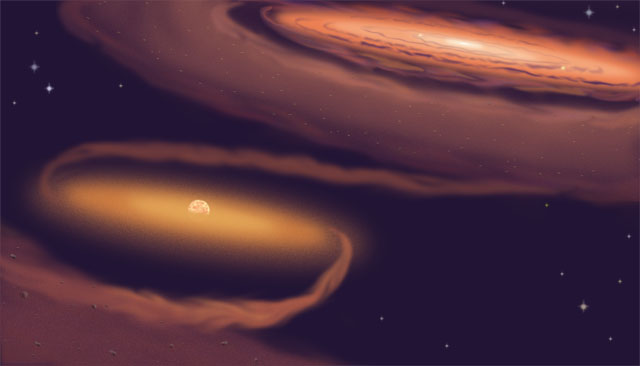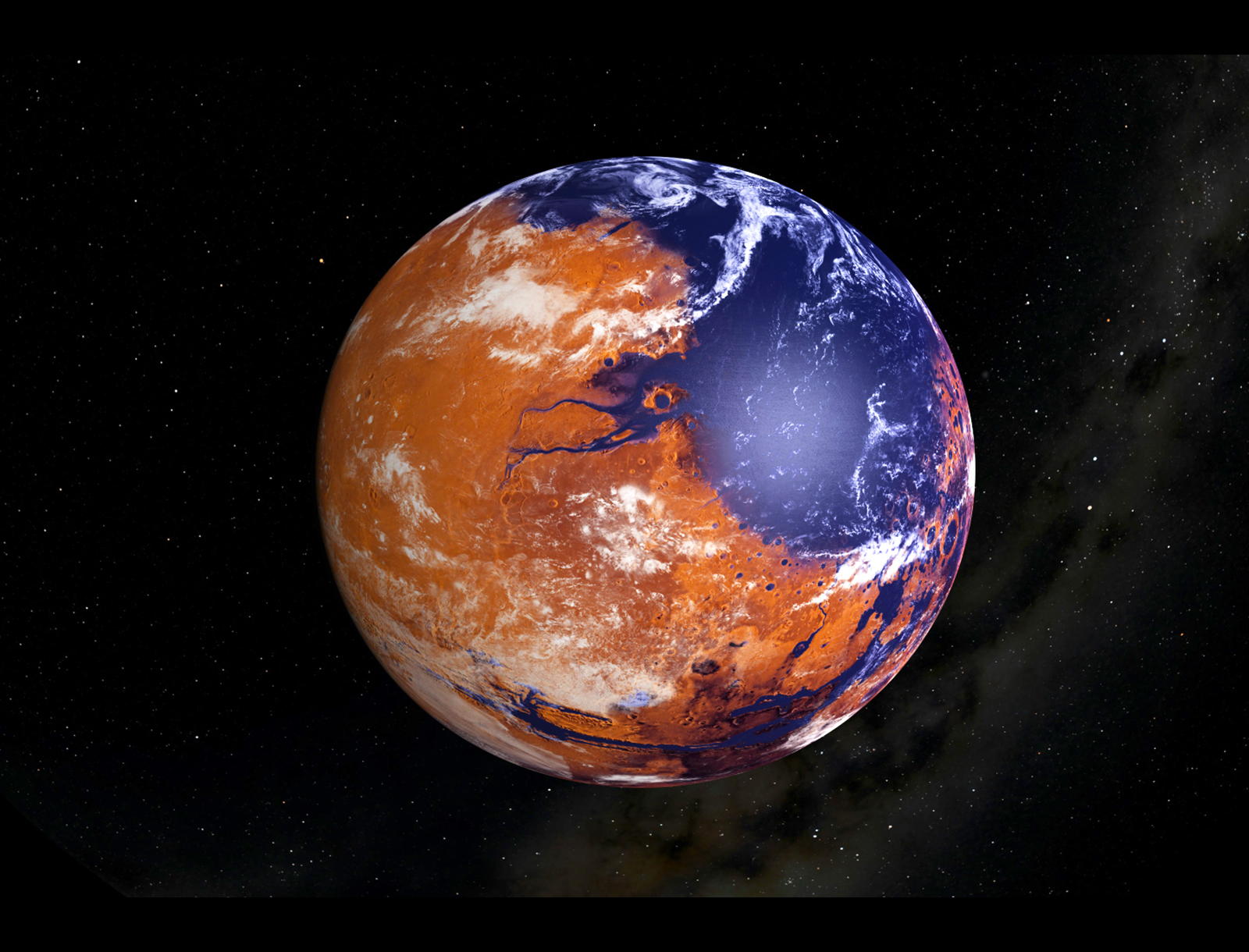Solar System Formation and Evolution

Circumstellar Disks
Most stars forming in our galaxy, like those of the Orion Nebula, are surrounded by disks of dust and hydrogen gas called circumstellar disks. Scientists study these disks to learn about processes that occurred billions of years ago in our solar nebula. Hubble Space Telescope image of the Orion Nebula, courtesy of C. R. O'Dell (Rice University) and NASA.

Planetesimals
In the solar nebula, dust and ice particles occasionally collided and merged. Through this accretion, these tiny particles formed larger bodies that eventually became planetesimals up to a few kilometers across. In the inner, hotter part of the nebula, planetesimals were composed of silicates and metals. In the outer, cooler portion, water ice was the dominant component.

Terrestrial Planets (Inner
Solar System)
Planetesimals were massive enough that their gravity influenced other planetesimals. This increased the frequency of collisions, causing the largest bodies to grow more rapidly, eventually becoming planetary embryos. Accretion continued until only four large bodies remained — Mercury, Venus, Earth, and Mars.
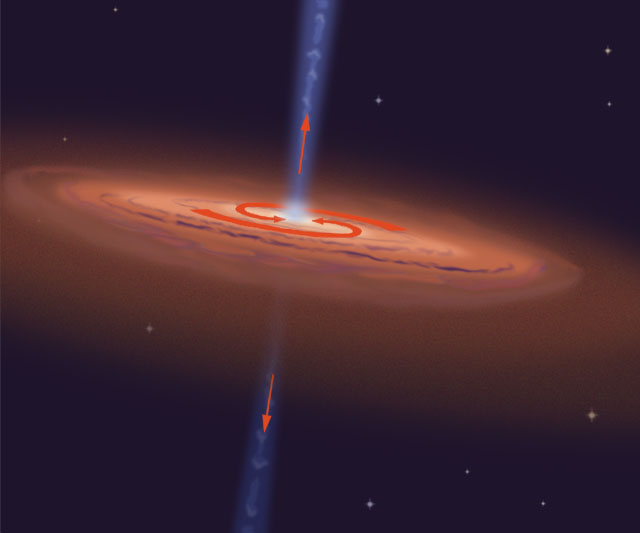
Solar Nebula Disperses
The growing proto-Sun accumulated much of the nebula’s material long before planets formed. A small portion was later incorporated into the planets, but the remainder was swept away when nuclear reactions were initiated in our Sun’s core. These reactions created a strong solar wind, which expelled the Sun’s outer layers far beyond our solar system. A much weaker solar wind continues to flow today.

Asteroids
Asteroids are rocky remnants from our early solar system; most orbit between the inner and outer planets. Occasionally, asteroids reach Earth’s surface as meteorites, providing scientists with information about the inner solar system.
Asteroid Itokawa image courtesy of the Japan Aerospace Exploration Agency (JAXA).
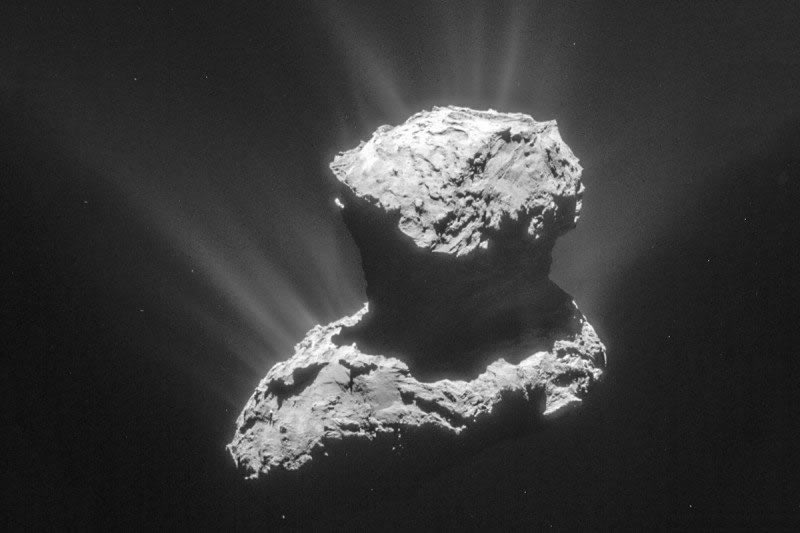
Comets
Comets formed in the outer reaches of our solar system early in its development. They are made of ice and dust, materials left from the original nebula. Comets periodically pass close enough to the Sun to heat up and release a long tail of dust and gas.
Comet 67P/Churyumov-Geraimenko, courtesy of the European Space Agency (ESA).
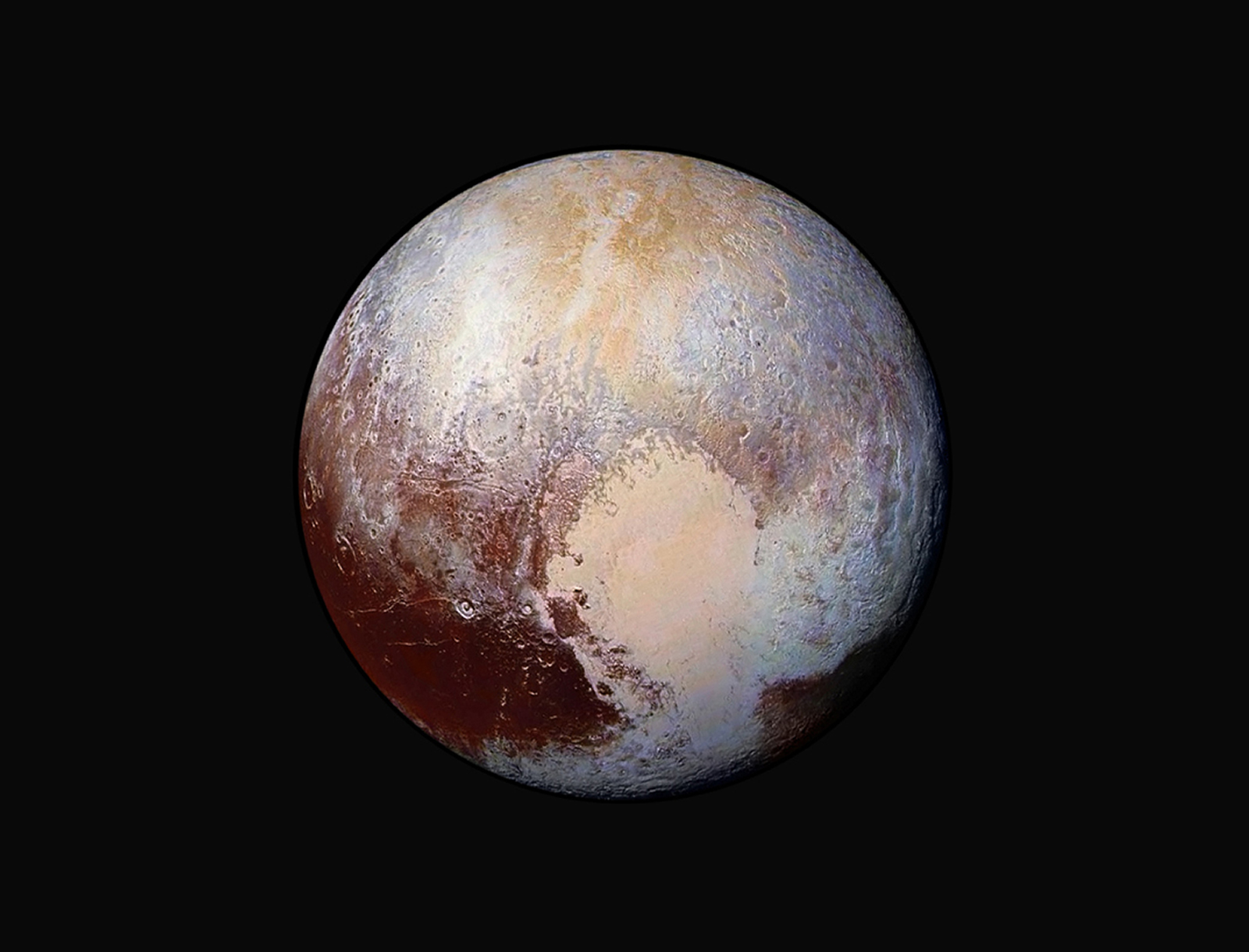
Kuiper Belt
Planetesimals that have not had enough time to accrete into planets populate the Kuiper belt, which extends beyond Neptune. Pluto, considered a dwarf planet, is a large member of the Kuiper belt. The Oort cloud envelops our solar system and contains icy planetesimals. Comets originate in the Oort cloud and the Kuiper belt.
Pluto image courtesy of NASA/Johns Hopkins University Applied Physics Laboratory/ Southwest Research Institute.

Planetary Layers
As the inner planets formed, they heated up. Their interiors melted and reorganized into layers of different densities. Melting was caused by heat from impactors striking and accreting, the sinking of heavy materials to the center, and the decay of radioactive elements. This reorganization caused the rocky planets to have dense, metal-rich inner cores, less-dense mantles, and outer crusts formed from the lightest materials.

Planetary Impacts
The last large asteroid impacts on the Moon occurredabout 3.8 billion years ago and produced impact basins up to 1000 kilometers across. Large basins on other planets — such as Mercury and Mars — are thought to have formed at the same time. Erosion, volcanism, and plate-tectonic forces erased traces of these ancient impacts on Earth. Although asteroids and comets continue to strike planets and moons throughout our solar system, the rate of impact events became less frequent after this time.
Lunar Reconnaissance Orbiter image of the Mare Orientale basin, courtesy of NASA/Goddard Space Flight Center/Arizona State University.

Mercury Cools
Mercury is covered in curving, cliff-like scarps and wrinkle ridges. These landforms were created when the planet’s crust contracted, or shrank, buckling the surface. This shrinking reduced Mercury’s radius by as much as 7 kilometers and occurred several hundred million years after the planet formed.
Mercury global image and detail of Carnegie Rupes courtesy of NASA/Johns Hopkins University Applied Physics Laboratory.
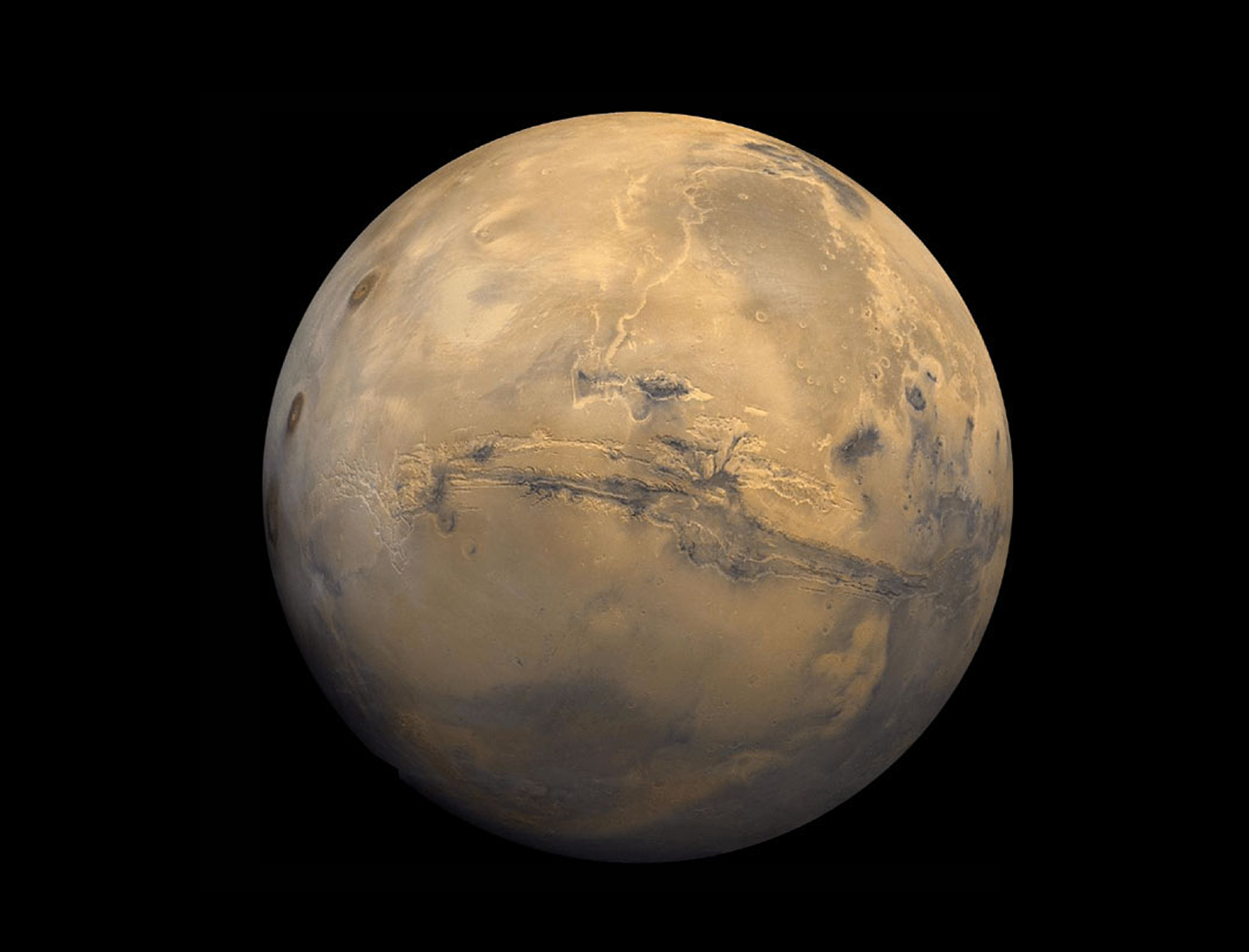
Valles Marineris, Mars
The Valles Marineris canyon system is over 10 kilometers deep in areas and stretches 4000 kilometers from end to end, about the same distance from California to New York. This canyon began forming 3.0 billion years ago as heat from the interior caused the crust to stretch and break.
Viking Orbiter 1 image, courtesy of NASA and the U.S. Geological Survey.

Outflow Channels on Mars
Occassionally, water trapped beneath the surface of Mars catastrophically flooded across the surface, carving huge channels up to 100 kilometers wide, 1 kilometer deep, and thousands of kilometers long. The floods left long mesas and teardrop-shaped islands, such as those in Osuga Vallis. The floods emptied into the northern lowlands, possibly creating short-lived seas.
Oblique view of Osuga Vallis, courtesy of the European Space Agency (ESA).

Meteorites from Mars
A few meteorites that have been found on Earth actually came from Mars. These rare samples provide scientists with information about the martian environment and history. Martian meteorites are between 4.5 billion and 180 million years old. This specimen cooled from a lava flow on Mars about 1.3 billion years ago.
Photograph of the Lafayette meteorite by Chip Clark, courtesy of the Smithsonian Institution.
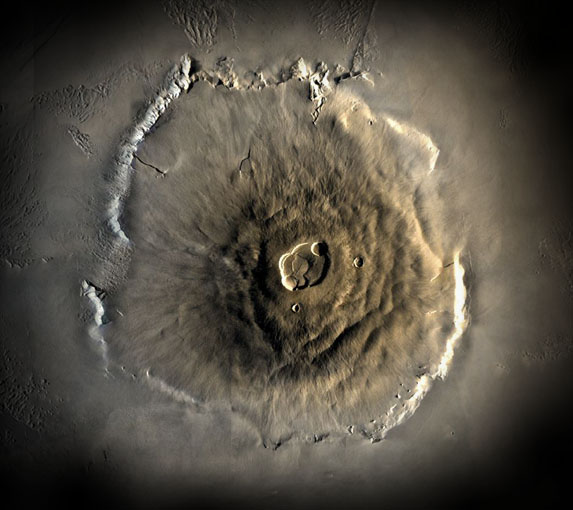
Olympus Mons, Mars
The age of Saturn's thin rings is not well known. Based on the rate at which the rings are spreading, they are estimated to be about 200 million years old. The rings are made of centimeter- to meter-sized particles of ice and dust. Voyager 2 image, courtesy of NASA and the Jet Propulsion Laboratory.

Lava Flows on Venus
Unlike other terrestrial planets, the surface of Venus is not heavily cratered. Most of the surface has been covered by lava flows in the last billion years. Volcanos probably continue to erupt on Venus today.
Computer-generated three-dimensional perspective view of the surface of Venus courtesy of NASA/Jet Propulsion Laboratory.

Rings of Saturn
The age of Saturn’s thin rings is not well known. Based on the rate at which the rings are spreading, they are estimated to be less than 200 million years old. The rings are made of centimeter- to meter-sized particles of ice and dust.
Cassini spacecraft images of Saturn and rings courtesy of NASA/Jet Propulsion Laboratory/ Space Science Institute.

Volcanism Ends on Mercury
Widespread effusive volcanism on Mercury ended relatively early in the planet’s history, about 3.5 billion years ago. However, some volcanic activity persisted until at least the last second-half of solar system history. The youngest volcanic material is found within the central-peak ring of the 290-kilometer diameter Rachmaninoff basin.
Rachmaninoff basin image courtesy of NASA/Johns Hopkins University Applied Physics Laboratory.



